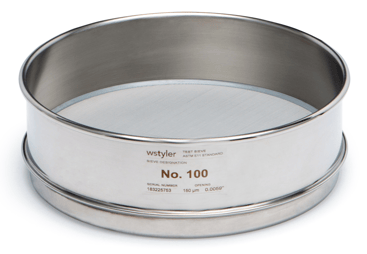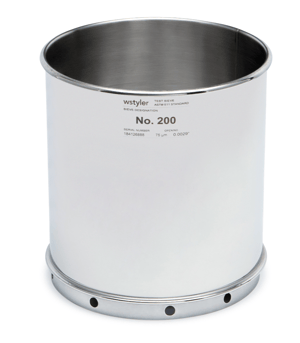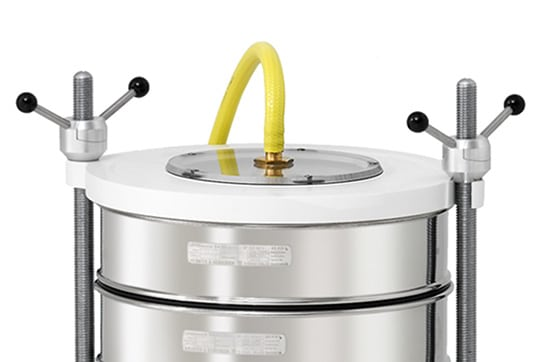Wet & Dry Sieve Analysis (Alloys, Certification, And Sizes + Video)
There is a lot of information out there about test sieves. Maybe you have even asked yourself some of these questions before:
- What is the difference between wet sieve analysis and dry sieve analysis?
- How do I know if I should use wet sieves or dry sieves?
- What is the procedure doing a wet sieve analysis?
There are two different types of woven wire sieves that we offer at W.S.Tyler: Wet Wash Sieves and Dry Test Sieves.
We don't even call it “dry” sieving because it is thought of as the norm or most common method. Most of the time customers and companies just refer to dry sieves as test sieves or sieves.
Wet Wash sieving is a little more uncommon, so we wrote this article to talk about wet-sieving and how it is different from dry sieving.
We hope that this article helps you get a better sense of when it is appropriate to choose wet sieving over the traditional method.
All dry and wet test sieves consist of the same components: frame, skirt, mesh. For more information about test sieves, in general, check out our article: What is a Test Sieve.
Dry Test Sieves

Dry, or traditional, sieving is used to determine the particle size of dry, free-flowing material.
These sieves are used by shaking or vibrating the sieve which allows the particles to seek the openings in the wire mesh. The particles are able to separate on their own. Industries like chemical, food and beverage, pharmaceutical, all use “dry” test sieves.
Wet Test Sieves

Wet sieving is used where there is a high concentration of fine particles that tend to stick together and won't separate using just mechanical shaking.
If the particles being sieved are mixed with materials like clay or silt they can clump together and not fit through the openings. Particles may seem to be solid and the correct size, but they are really made up of smaller particles clumped together.
In our experience, wet wash sieving is used most often for quality control in the aggregate industry. However, this does not mean wet wash sieves are restricted for this use.
If those particles are used for a structure or a road, over time the particles may start to separate into their true size causing things to fall apart or crumble.
Wet wash sieves were created for these situations. Wet wash sieves have higher frames to them. This creates more Volume for the sample.
How is a Wet Wash Sieve Analysis Performed?
It is important to be sure no material spills over the frame of the sieve.
Each sieve and retained material is dried before weighing and recording results. Use a drying oven set to no more than 250 degrees Fahrenheit.
Wet wash sieves work for materials that are insoluble in water.
Alloy
Wet test sieves are available in the following alloys for the frame and wire mesh cloth:
- Stainless Steel Frame, Stainless Steel Mesh
- Brass Frame, Stainless Steel Mesh
Dry test sieves are available three different alloy combinations:
- Stainless steel frame, Stainless steel cloth
- Brass frame, Brass cloth
- Brass frame, stainless steel cloth
Sieves have been around for a long time and there is a common misconception that brass test sieves are more durable or the better sieve.
Brass frame test sieves are known to wear down faster than stainless steel. Stainless steel sieves are 3 times as strong as brass and are more corrosion resistant.
Sieve Sizes
Diameter
Dry test sieves are available in the following diameters: 3in, 6in, 200mm, 8in, 10in, 300mm, 12 in., and 18in
Wet Test Sieves are available in the following diameters: 3in, 8in, 12in
Height
Dry test sieves are available in both half-height and full-height sieves.
Half height sieves can be used on a sieve shaker to allow more sieves to fit into the sieve stack on your machine.
Wet test sieves are all manufactured with a height of 4 inches. This height is what allows the sample more room when you add the wet solution.
For more information on how sieve size effects particle size analysis, refer to our article: How Sieve Size and Sample Weight Affect Particle Analysis.
Sieve Shakers and Wet Wash Sieves
The W.S. Tyler RO-TAP® Sieve Shakers work with 8 inch and 12 inch regular or “dry” test sieves.

Although Wet Wash Sieves are not able to be placed into the sieve shakers themselves. We do sell a kit that will allow you to use the wet sieving process with your RO-TAP Sieve Shaker.
The kit includes everything you need to perform a wet sieve analysis using your standard 8-inch sieves on your RO-TAP. The kit is available for both the RX-29 Model and the RX-94.
ISO and ASTM Sieves
All sieves are available in all ISO and ASTM opening sizes. They are serialized and supplied with certificates stating they were manufactured to meet the requirements for either ASTM or ISO.
Certified Test Sieves
A lot of industries out there have written standards that dictate the level of standards their sieves need to be performing at. This keeps their quality control in check and also eliminates wasted material.
All of our dry and wet test sieves are able to be upgraded from a compliance level above (which is provided with every sieve) to two different levels of certification. This sends the sieves through a process that verifies the openings in the sieve.
For more information on sieve certifications, you can check out our article: What is Test Sieve Certification
To Sum It All Up
The most important thing to remember when it comes to choosing test sieves is that your material and particle size is always the best place to start.
You will be faced with a few decisions when it comes to the sieving method, depending on your price range and a few other factors, but the method of sieving itself will be dictated by your material and particle size.
If you have more questions about test sieves here are a few more articles that might be valuable to you:
- Are my Test Sieves Accurate? (Tips and Troubleshooting)
- 5 Tips for Maintaining Your Test Sieves
If you have any questions about wet test sieving, feel free to reach out to us and we will be happy to work through them with you.
Want all the latest industry trends and innovations sent directly to your inbox? Subscribe to our monthly newsletters today!



